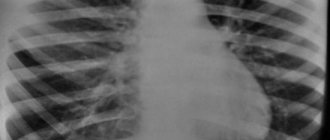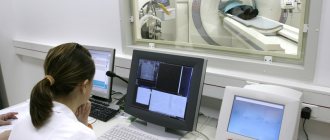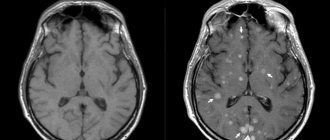Why do tattoos limit MRI?
Modern tomographs are equipped with powerful magnetic field sources: electromagnets or permanent magnets. Using MRI, it is possible to monitor the functioning of all human vital systems and diagnose the occurrence of pathologies without invasive intervention. The magnetic nuclear resonance method is based on studying the concentration of protons in body tissues. Each of them has individual magnetic properties because they are surrounded by molecules with different properties.
Note! “The magnetic field of the tomograph is so powerful that any object, even with a small metal content, is set in motion. This can be fatal to humans."
More than 30 years ago, tattoos were filled with a single metal needle. In this case, chemical compounds of red, blue, and black colors were used. For greater durability, chemicals with a high metal content were added to the dyes. It is difficult to predict how metal particles will behave under the influence of a powerful magnetic field. What else is important to know about MRI?
Is it possible to have an MRI with tattoos?
kickassthings.com
Contraindications to magnetic resonance imaging are not limited to the obvious presence of metal devices, such as an Ilizarov apparatus or a pacemaker. Among the relative contraindications are a number of diseases and characteristics of the body for which it is not recommended to perform the study unless absolutely necessary. From panic attacks and claustrophobia to insulin pumps and nerve stimulants, these are all relative contraindications to MRI. But there are not so obvious aspects, the presence of which can cause harm to the person undergoing the study, among them are tattoos.
Tattoos made with ferromagnetic metal compounds may cause skin burns due to electromagnetic reactions. Tattoos with black pigment containing iron oxide can be dangerous. These compounds could theoretically create an electrical current that increases the local temperature enough to cause a burn. There are publications describing a case of burns to the extremities during an MRI of patients with tattoos. Patients who experience such reactions may use symptomatic treatment with a cold compress to complete the study. Using a towel or cloth between tattoos on different areas of the body may be an alternative way to reduce the adverse reaction.
The first report of an MRI reaction to a patient's skin due to a tattoo was described in 1997. The patient in this report experienced sudden burning pain in the area of his abdominal tattoo. This occurred simply in the presence of a static magnetic field upon entering the MRI room. The authors of the publication confirmed the ferromagnetic properties of tattoo pigment by documenting the migration of elliptical skin in the direction of a standard horseshoe magnet. They also studied the ferromagnetic properties of common tattoo pigments and showed that iron oxide-based pigments (most often black and brown) were displaced by the magnetic field, while carbon-, titanium-, and copper-based pigments were not affected.
Following the initial report described above, 2 other cases of skin burns following MRI were described in 2000. One patient had a large tattoo (20 × 10 cm) of a dragon with "bright flowers and several loops of tail and neck." It has been suggested that tattoos containing electrically conductive material that are applied to the dermis in a loop pattern are most at risk for a skin reaction. These particular tattoos can induce an electrical current and thus burn the skin by following the radiofrequency pulse of the MRI process. It is possible that the combination of size, ferromagnetic pigment, and loops of the tattoo caused the first degree burn noted in this patient. The second patient suffered a second-degree burn to his right deltoid, in the area of a tattoo consisting of two milky black lightning bolts surrounding a Chinese symbol. Interestingly, the skin reaction only occurred above and around the lightning bolt, with no central symbol. The tattoo ink supplier was contacted and it was discovered that the dark tattoo ink contained high concentrations of iron oxide, which was shown to be highly ferromagnetic.
Thermal injuries have been reported during MRI procedures, primarily associated with monitoring systems, including sensors, cables, or other foreign objects placed on the patient's skin. These injuries are believed to result from currents induced in conductive objects by MRI coils, which create heat and ultimately cause burns. Demonstrations of highly detectable ferromagnetic characteristics in tattoos and cosmetics have been reported in various journals. It is noteworthy that mascara and tattoos containing heavy metal particles located in the eyelid and eye area can cause a change in the local magnetic field in neighboring tissues. These changes cause the globes to become distorted. In some cases, the distortion can mimic a real eye disease, such as ciliary body melanoma or cyst.
How does MRI affect tattoos?
Tattoos made decades ago do not always contain metal particles. What to do if magnetic resonance imaging is necessary for health reasons, but there is a small tattoo on the body? Radiologists advise finding the appropriate equipment - a device for determining the content of metal particles. This could be a metal detector or something similar.
Useful information : “You should not immediately look for equipment from friends or acquaintances. First, you need to consult with your doctor, perhaps he will suggest a different diagnostic option.”
The coloring pigments of modern tattoos do not contain metal particles.
More than a decade ago, when MRI scans were just beginning to be used to diagnose diseases, patients with tattoos were allowed to undergo the procedure. Some of them experienced the following sensations:
- Tingling sensation in the area where the tattoo was applied.
- Severe burning sensation.
- Drawing pain.
SO WHAT DOES THIS HAVE TO DO WITH TATTOOS?
More than 20 years ago, tattoo ink sometimes included small pieces of metal. Recently, such inks are practically not used. Some patients with tattoos that were done a long time ago have reported slight discomfort or even severe pain during an MRI. It is believed that the reason for this was that magnetic forces pulled the metal fragments of the ink so strongly that it caused a burning sensation at the tattoo site. However, even if there is no pain at all, these metal fragments can cause artifacts that distort the MRI scan image.
If the tattoo was done within the last 20 years, then it is certain that it will not be a problem for an MRI. Even if a tattoo is over 20 years old, this does not mean that the ink absolutely contains metal. And even if they contain metal, this does not mean that there will definitely be problems with MRI.
However, it makes sense to tell your doctor about any tattoos you have. Remember that there is always an alternative to MRI. For example, people with pacemakers and metal implants must find other diagnostic methods.
MRI and tattoos
Is it possible to perform an MRI if there are tattoos on the skin?
How do experts explain the unpleasant sensations caused by a drawing made on the skin:
- Under the influence of strong magnets, metal particles begin to attract each other. As a result of the friction effect, a person experiences hyperthermia.
- Molecules of metal compounds begin to move in the tissues towards the magnets. The patient feels pain and (or) burning.
After complaints about unpleasant symptoms during magnetic resonance imaging, the list of MRI contraindications was expanded to include tattoos and other objects containing metal.
Important: “The coloring pigments of modern tattoos do not contain metal particles. Dermatologists have found that metal molecules can cause melanoma and other malignant tumors. But, if you suspect the presence of titanium, you should consult a doctor for advice.”
It is up to the doctor to decide whether it is possible to do an MRI if you have a tattoo. Most likely, he will prefer not to risk finding out whether there is metal in the pattern on the skin or not there. The patient will be offered an ultrasound or computed tomography for diagnosis.
The importance of ink composition
In 2011, a medical report was published for Sports Health, which described a case in which one of the patients suffered a serious burn while undergoing an MRI. It's the composition of the ink. In this situation, the ferrous metal compounds acted as an electrical conductor, raising the temperature of the skin to a level sufficient to cause a burn.
The composition of the ink varies not only in color, but also in the composition used by manufacturers. Any pigment is quite capable of causing an allergic reaction in a particular person. This may be cobalt, zinc, manganese, chromium, lead, titanium dioxide, nickel, copper or carbon black.
Russians' demand for tourism almost tripled after self-isolation was lifted
A healthy dessert that is no worse than cakes: baked apples with pumpkin
The mentor asked the students: “What is the only thing that belongs to each of us?”
If the composition contains iron oxide, then other problems may arise during MRI. Ferrous metals have the property of being magnetized, and this can cause the consequences that occurred in 2011. The FDA warns that some patients may experience a slight burning or tingling sensation during an MRI scan.
However, most people with tattoos tolerate the procedure quite easily. How big is the risk?
When should you not undergo a tomography with a tattoo?
A limitation to the tattoo is the presence of loose steel fragments. With strong fixation inside the bone, no movement can be observed. The strongest magnet is not capable of moving plates, knitting needles, or screws fixed inside the bone.
Loose fragments in soft tissues are displaced. The only inconvenience is image artifacts. If you want to explore a remote area, there are no restrictions. Before the appointment, it is necessary to decide whether a tattoo affects MRI in order to prevent negative manifestations.
Doubtful conditions are a contraindication. The old dyes were macromolecular, so they provoked adverse reactions - tingling, burning, nagging pain.
Use caution when ordering an MRI for an intrauterine device, as some types heat up or move in the magnetic field.
For emergency indications, radiology doctors perform an examination only after eliminating metal inclusions in the tattoo after analyzing the site of application with a metal detector. The devices are not available in public clinics, but some private institutions are equipped with devices.
Why can’t you do an MRI with a tattoo without first determining the composition of the tattoo ink? Metal parts move under the influence of a magnetic field. The person feels a burning sensation, tingling. The study is stopped immediately after discomfort appears.
Coloring pigments provoke malignant diseases - melanoma, skin cancer. You can't risk your health! It is better to have a CT scan (even after exposure to radiation) than to have complications immediately during diagnosis.
Modern permanent makeup and MRI are compatible, but a preliminary determination of the characteristics of the paint is required.










